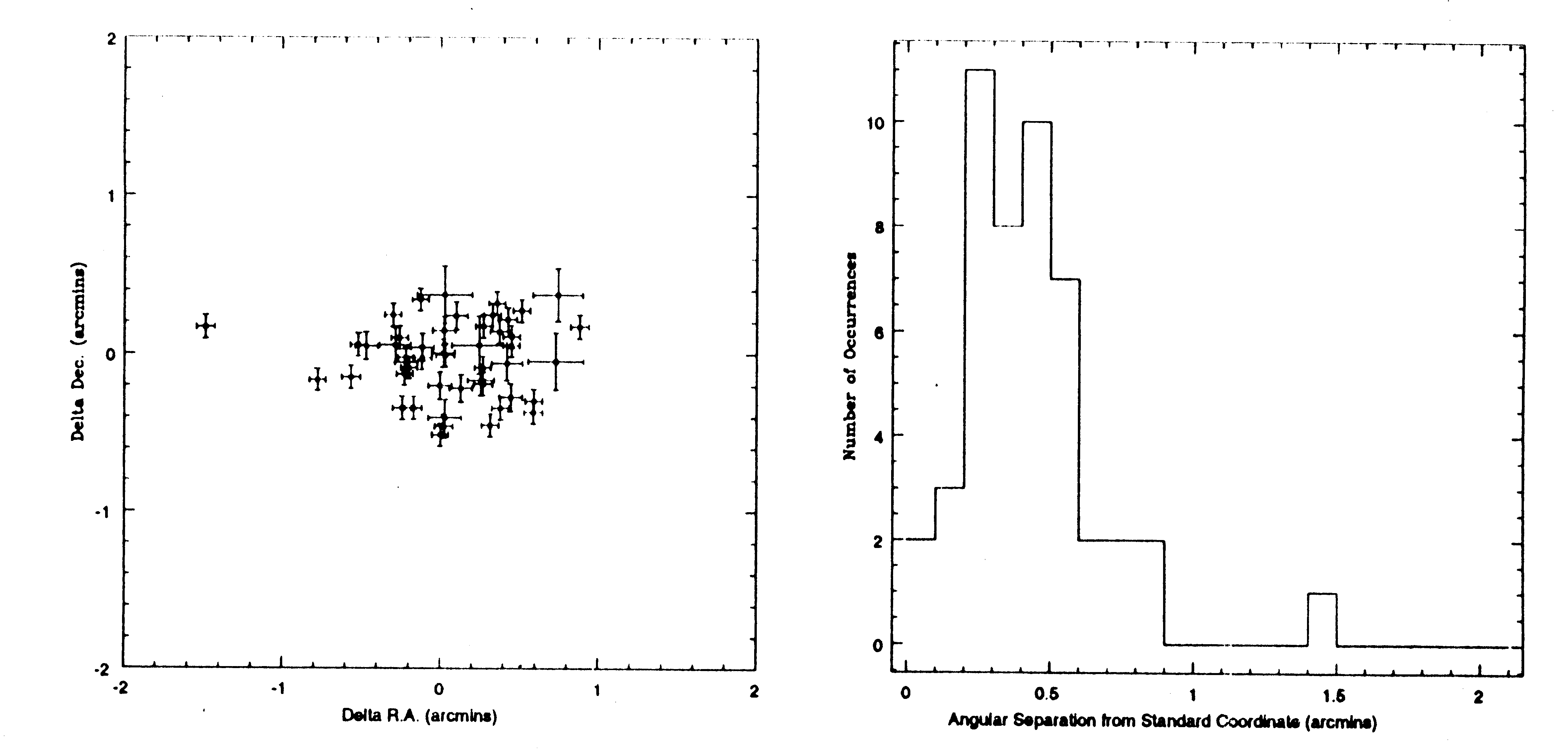 Click for a larger version.
Click for a larger version.
From the proceedings of the "Conference for the ASCA 3rd Anniversary - X-Ray Imaging and Spectroscopy of Cosmic Hot Plasmas", held March 11-14, 1996 at Waseda University, Tokyo, Japan.
(1) Code 660.2, NASA/GSFC, Greenbelt, MD, 20771, USA.
(2) University of Minnesota, 116 Church St. SE, Minneapolis, MN 55455, USA.
We measure the accuracy of the ASCA source positions associated with the standard (REV1) processing, and determine the various error contributions. Time averaged SIS images are constructed using screened event data from the ASCA (REV1) archive, processed with the latest software and calibration files. The measured positions of 48 moderately bright SIS point sources, selected in an unbiased manner, are compared with accurately known (mainly optical) coordinates. The ensemble of measured deviations is consistent with zero systematic offset and random scatter in angle; the magnitude of these deviations yields a mean of ~ 0.4 arcmins and a 90% confidence error circle of 40 arcsecs radius. We consider possible unaccounted systematic time dependent deviations associated with ASCA's orbit/pointing/solar geometry, with an eye on future prospects for improving the attitude reconstruction.
It is useful to determine the accuracy of the measured ASCA source positions. We can quantifying the ASCA error circle for source identification; perform an end-to-end check of the attitude solution, calibration files, and aspecting and imaging software; and identify contributions to the overall pointing accuracy. This calibration forms the basis for improving the pointing accuracy for ASCA REV2 processing and, ultimately, for the ASTRO-E mission.
Our method is as follows. We identified bright well-known sources from ASCA PV and AO1 sequences and constructed SIS images using screened event data from the ASCA (REV1) archive, processed with the latest software and calibration files. The images were made by merging exposure corrected sky images from both SIS cameras, and the sky positions of our selected sources were found by fitted their peaks with a bi-quadratic function. Cataloged coordinates where obtained mostly via BROWSE (HIC & PMM) and/or the literature, taking into account proper motion as necessary. We eliminated pointings associated with known aspect uncertainties (such as Gyro problems). Typical errors are ~ 2" (optical), ~ 10" (x-ray).
The results are summaries in Figs 1 - 2. The offsets in RA and DEC are distributed randomly and centered on zero. There is no significant systematic shifts in dRA or dDEC in any preferred direction, within measurement error. The distribution of angular displacements yield a mean of ~ 0.4 arcmins, with a 90% confidence error circle of 40 arcsecs.
The measurement accuracy is ~ 5" as determined from measurements of image fields with multiple sources; and the plate scale is found to be linear over the SIS FOV and consistent with expectation, to within measurement errors.
Relative sky reconstruction is consistent with the pointing stability of the satellite, with its ~ ten arcsec precision. This is apparent by comparing the reconstruct image of a point source to both to ground calibration data (WSMR flight spare mirror and CCD camera) and snapshots of various lengths of bright source (allowing for pile-up, as necessary).
The offsets are not correlate with the day-of-year or show any obvious periodic effect on a year time-scale. Furthermore, adding and subtracting twice the annual aberration only increases the error circle. These facts suggest that the annual aberration is correctly applied.
It may be possible to improve the ASCA error circle by a factor of 2 or 3 because the attitude solution has been shown to track the detailed pointing to ten arcsec precision. The large error circle is due to a random offset error in the absolute pointing between observations, which is stable over an observation. This absolute pointing error is introduced in the attitude solution itself. We hope to model this offset for a given pointing, and thus improve the pointing accuracy.
The above study was confined to images which where time averaged over many orbits. Some work is underway to study variations in the source positions as a function of the orbital, and other geometric parameters. We considered the effects of day vs. night, and bright vs. dark Earth on the measured positions and find small shifts in the offsets of order 0.1 arcmins, probably due to temperature effects. However the results are not conclusive yet.
We compared the measured position of 48 SIS point sources to cataloged values and derive an ASCA error circle of 40 arcsecs radius (90% confidence level), and mean of ~ 0.4 arcmins. The offsets are consistent with a random shift in RA/DEC between pointings.
1 Latest REV1 software is OK. (Images are correctly oriented, annual aberration is applied in the correct sense)
2 Calibrations OK, mirrors nominal.
3 SIS measurement of point source positions are good to ~ 5".
4 The attitude reconstruction during an observation is reasonable (~ 10").
5 The error circle is centered on zero offset and is consistent with a random distribution.
6 Large error circle mean of ~ 0.4' radius due to absolute offset in the attitude solution from observation to observation.
Figure 1. Figure 2.